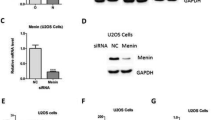Abstract
Increasing evidence suggests that the three homologous members of steroid receptor co-activator (SRC) family (SRC-1, SRC-2, and SRC-3) play key roles in enhancing cell proliferation in various human cancers, such as breast, prostate, and hepatocellular carcinoma. However, the function of SRC-3 in osteosarcoma remains largely unexplored. In the current study, we found that SRC-3, but not SRC-1 and SRC-2, was dramatically up-regulated in human osteosarcoma tissues, compared with adjacent normal tissues. To explore the functions of SRC-3 in osteosarcoma, in vitro studies were performed in MG63 and U2OS cells. SRC-3 overexpression promoted osteosarcoma cell proliferation, whereas knockdown of SRC-3 inhibits its proliferation. In support of these findings, we further demonstrated that SRC-3 up-regulated FoxM1 expression through co-activation of C/EBPγ. Together our results show that SRC-3 drives osteosarcoma progression and imply it as a therapeutic target to abrogate osteosarcoma.






Similar content being viewed by others

References
Luo Y, Deng Z, Chen J. Pivotal regulatory network and genes in osteosarcoma. Arch Med Sci. 2013;9:569–75.
Poos K, Smida J, Nathrath M, Maugg D, Baumhoer D, et al. How microRNA and transcription factor co-regulatory networks affect osteosarcoma cell proliferation. PLoS Comput Biol. 2013;9:e1003210.
Xu J, Wu RC, O'Malley BW. Normal and cancer-related functions of the p160 steroid receptor co-activator (SRC) family. Nat Rev Cancer. 2009;9:615–30.
Gojis O, Rudraraju B, Gudi M, Hogben K, Sousha S, et al. The role of SRC-3 in human breast cancer. Nat Rev Clin Oncol. 2010;7:83–9.
York B, Yu C, Sagen JV, Liu Z, Nikolai BC, et al. Reprogramming the posttranslational code of SRC-3 confers a switch in mammalian systems biology. Proc Natl Acad Sci U S A. 2010;107:11122–7.
York B, O'Malley BW. Steroid receptor coactivator (SRC) family: masters of systems biology. J Biol Chem. 2010;285:38743–50.
Johnson AB, O'Malley BW. Steroid receptor coactivators 1, 2, and 3: critical regulators of nuclear receptor activity and steroid receptor modulator (SRM)-based cancer therapy. Mol Cell Endocrinol. 2012;348:430–9.
Walsh CA, Qin L, Tien JC, Young LS, Xu J. The function of steroid receptor coactivator-1 in normal tissues and cancer. Int J Biol Sci. 2012;8:470–85.
McBryan J, Theissen SM, Byrne C, Hughes E, Cocchiglia S, et al. Metastatic progression with resistance to aromatase inhibitors is driven by the steroid receptor coactivator SRC-1. Cancer Res. 2012;72:548–59.
Agoulnik IU, Weigel NL. Androgen receptor coactivators and prostate cancer. Adv Exp Med Biol. 2008;617:245–55.
Long W, Foulds CE, Qin J, Liu J, Ding C, et al. ERK3 signals through SRC-3 coactivator to promote human lung cancer cell invasion. J Clin Invest. 2012;122:1869–80.
Wang Y, Lonard DM, Yu Y, Chow DC, Palzkill TG, et al. Small molecule inhibition of the steroid receptor coactivators, SRC-3 and SRC-1. Mol Endocrinol. 2011;25:2041–53.
Mussi P, Yu C, O'Malley BW, Xu J. Stimulation of steroid receptor coactivator-3 (SRC-3) gene overexpression by a positive regulatory loop of E2F1 and SRC-3. Mol Endocrinol. 2006;20:3105–19.
Liontos M, Niforou K, Velimezi G, Vougas K, Evangelou K, et al. Modulation of the E2F1-driven cancer cell fate by the DNA damage response machinery and potential novel E2F1 targets in osteosarcomas. Am J Pathol. 2009;175:376–91.
Jin R, Sun Y, Qi X, Zhang H, Zhang Y, et al. E2F1 is involved in DNA single-strand break repair through cell-cycle-dependent upregulation of XRCC1 expression. DNA Repair (Amst). 2011;10:926–33.
Wu RC, Qin J, Yi P, Wong J, Tsai SY, et al. Selective phosphorylations of the SRC-3/AIB1 coactivator integrate genomic reponses to multiple cellular signaling pathways. Mol Cell. 2004;15:937–49.
Li S, Shang Y. Regulation of SRC family coactivators by post-translational modifications. Cell Signal. 2007;19:1101–12.
Li X, Lonard DM, Jung SY, Malovannaya A, Feng Q, et al. The SRC-3/AIB1 coactivator is degraded in a ubiquitin- and ATP-independent manner by the REGgamma proteasome. Cell. 2006;124:381–92.
Wu RC, Feng Q, Lonard DM, O'Malley BW. SRC-3 coactivator functional lifetime is regulated by a phospho-dependent ubiquitin time clock. Cell. 2007;129:1125–40.
Radhakrishnan SK, Bhat UG, Hughes DE, Wang IC, Costa RH, et al. Identification of a chemical inhibitor of the oncogenic transcription factor forkhead box M1. Cancer Res. 2006;66:9731–5.
Teh MT, Gemenetzidis E, Chaplin T, Young BD, Philpott MP. Upregulation of FOXM1 induces genomic instability in human epidermal keratinocytes. Mol Cancer. 2010;9:45.
Li Q, Zhang N, Jia Z, Le X, Dai B, et al. Critical role and regulation of transcription factor FoxM1 in human gastric cancer angiogenesis and progression. Cancer Res. 2009;69:3501–9.
Wang IC, Chen YJ, Hughes D, Petrovic V, Major ML, et al. Forkhead box M1 regulates the transcriptional network of genes essential for mitotic progression and genes encoding the SCF (Skp2-Cks1) ubiquitin ligase. Mol Cell Biol. 2005;25:10875–94.
Wang IC, Chen YJ, Hughes DE, Ackerson T, Major ML, et al. FoxM1 regulates transcription of JNK1 to promote the G1/S transition and tumor cell invasiveness. J Biol Chem. 2008;283:20770–8.
Acknowledgments
This work was partially supported by National Natural Science Foundation of China (81271984), Research Fund for the Doctoral Program of Higher Education of China (20122307120036), Natural Science Foundation for Returnees of Heilongjiang Province of China (LC2012C11), Research Fund for Returnees of Education Department of Heilongjiang Province of China (1253HQ003), Research Fund of the First Affiliated Hospital of Harbin Medical University(2013LX01).
Conflicts of interest
None
Author information
Authors and Affiliations
Corresponding authors
Additional information
Shuo Geng and Xiaoyu Wang contributed equally to this work.
The Publisher and Editor retract this article in accordance with the recommendations of the Committee on Publication Ethics (COPE). After a thorough investigation we have strong reason to believe that the peer review process was compromised.
An erratum to this article can be found online at http://dx.doi.org/10.1007/s13277-017-5487-6.
Electronic supplementary material
Below is the link to the electronic supplementary material.
Supplementary Figure 1
Representative protein levels of SRC-3 were analyzed by western blot in normal tissues (N) or osteosarcoma tissues (OS). (JPEG 0 kb)
About this article
Cite this article
Geng, S., Wang, X., Xu, X. et al. RETRACTED ARTICLE: Steroid receptor co-activator-3 promotes osteosarcoma progression through up-regulation of FoxM1. Tumor Biol. 35, 3087–3094 (2014). https://doi.org/10.1007/s13277-013-1406-7
Received:
Accepted:
Published:
Issue Date:
DOI: https://doi.org/10.1007/s13277-013-1406-7



